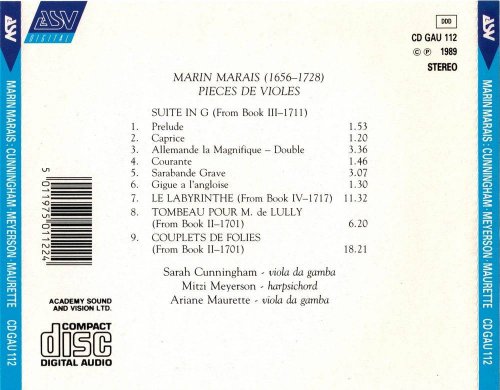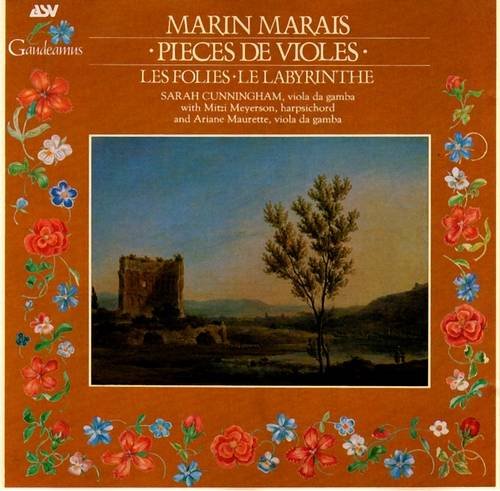
Sarah Cunningham, Mitzi Meyerson, Ariane Maurette - Marais: Pièces de Violes, Les Folies, Le Labyrinthe (1989) CD-Rip
BAND/ARTIST: Sarah Cunningham, Mitzi Meyerson, Ariane Maurette
- Title: Marais: Pièces de Violes, Les Folies, Le Labyrinthe
- Year Of Release: 1989
- Label: ASV / Gaudeamus
- Genre: Classical
- Quality: FLAC (image+.cue,log,scans)
- Total Time: 50:00
- Total Size: 320 Mb
- WebSite: Album Preview
Tracklist:
1. Ste in G: Prld
2. Ste in G: Caprice
3. Ste in G: Allemande La Magnifique - Double
4. Ste in G: Courante
5. Ste in G: Sarabande Grave
6. Ste in G: Gigue A L'angloise
7. Le Labyrinthe
8. Tomeau Pour M. De Lully
9. Couplets De Folies
Performers:
Sarah Cunningham (viola da gamba)
Mitzi Meyerson (harpsichord)
Ariane Maurette (viola da gamba)

1. Ste in G: Prld
2. Ste in G: Caprice
3. Ste in G: Allemande La Magnifique - Double
4. Ste in G: Courante
5. Ste in G: Sarabande Grave
6. Ste in G: Gigue A L'angloise
7. Le Labyrinthe
8. Tomeau Pour M. De Lully
9. Couplets De Folies
Performers:
Sarah Cunningham (viola da gamba)
Mitzi Meyerson (harpsichord)
Ariane Maurette (viola da gamba)
Sarah Cunningham is probably the finest viol player in Britain today, though it Is as a chamber-music player rather than as a soloist that she is best known here and abroad. Her technical command of the seven-string bass viol is never in doubt on this CD; nor, for that matter, is her control of tone. She has chosen some of Marais' most familiar and demanding works on which to make her solo recording debut, thereby inviting comparisons with the previous generation of players, Wieland Kuijken and Jordi Savall. Interpretatively, she is closer in spirit to the former than the latter—more Marais than Forqueray, one might say—but, unlike either Kuijken or Savall, she reveals little of herself beyond her devotion to the music.
The G major Suite from the third book of Pieces de viole is beautifully played, though for my taste there could have been more rhetoric in the Prelude, more panache in the double of the Allemande, more wistfulness in the petite reprise of the Courante and also more dance-like articulations before the strong second beats of the otherwise seemless Sarabande. The Tombeau pour M de Lully might have been even more eloquently delivered had there been more breaths of silence. (No one could have pretended to grieve much for Lully, but his death held profound implications for his contemporaries and would have inspired the awe infused in this work.) These, perhaps, are the quibbles of a fellow player.
More disconcerting by far is the accompaniment (indeed, throughout the recording), which calls too much attention to itself, giving the impression of understudies discontent in the wings. To be fair, the engineers may have contributed to this misinterpretation of textural balance, but it is ironic that Cunningham should be hampered by it when one recalls her own tactful and appropriate accompaniments on the behalf of other soloists.
The Labyrinthe and the Couplets de Folies are long and demanding works which amply demonstrate Cunningham's virtuosity, strength and musicianship. She gives unfailingly scrupulous readings of the text, though she might have infused more wit and abandon here and there in the Labyrinthe, whose gravement might have been enhanced by an attitude of mock pathos. Only in the couplets, which are so deeply gratifying to play, does she seem really to enjoy herself.'
The G major Suite from the third book of Pieces de viole is beautifully played, though for my taste there could have been more rhetoric in the Prelude, more panache in the double of the Allemande, more wistfulness in the petite reprise of the Courante and also more dance-like articulations before the strong second beats of the otherwise seemless Sarabande. The Tombeau pour M de Lully might have been even more eloquently delivered had there been more breaths of silence. (No one could have pretended to grieve much for Lully, but his death held profound implications for his contemporaries and would have inspired the awe infused in this work.) These, perhaps, are the quibbles of a fellow player.
More disconcerting by far is the accompaniment (indeed, throughout the recording), which calls too much attention to itself, giving the impression of understudies discontent in the wings. To be fair, the engineers may have contributed to this misinterpretation of textural balance, but it is ironic that Cunningham should be hampered by it when one recalls her own tactful and appropriate accompaniments on the behalf of other soloists.
The Labyrinthe and the Couplets de Folies are long and demanding works which amply demonstrate Cunningham's virtuosity, strength and musicianship. She gives unfailingly scrupulous readings of the text, though she might have infused more wit and abandon here and there in the Labyrinthe, whose gravement might have been enhanced by an attitude of mock pathos. Only in the couplets, which are so deeply gratifying to play, does she seem really to enjoy herself.'

Classical | FLAC / APE | CD-Rip
As a ISRA.CLOUD's PREMIUM member you will have the following benefits:
- Unlimited high speed downloads
- Download directly without waiting time
- Unlimited parallel downloads
- Support for download accelerators
- No advertising
- Resume broken downloads


